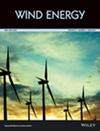垂直轴风力涡轮机的周期内转速控制
IF 3.3
3区 工程技术
Q3 ENERGY & FUELS
引用次数: 0
摘要
目前,水平轴风力涡轮机(HAWT)在风能市场上占据主导地位;然而,垂直轴风力涡轮机(VAWT)因其重心低、易于接触传动系统部件以及整体简单性等特点,正逐渐成为一种设计替代方案,尤其适用于深水海上选址。由于大型达里厄斯 VAWT 没有变桨机构,因此通常使用失速控制来管理功率和负载。有人研究过在 H 型 VAWT 中引入变桨机构,但这削弱了机械简单的优势,而且在大型达里厄斯型 VAWT 中使用变桨机构并不实用。本研究采用了一种创新的替代方法来控制大型 5 MW VAWT 的转子动态,以便在限制负载的同时最大限度地提高功率,而无需引入任何新的或复杂的机械元件。这种控制策略被称为周期内每分钟转数(RPM)控制,即允许涡轮机的转速随叶片方位角位置的变化而以最佳方式变化,而不是典型的恒定转速运行。为开环优化控制问题制定了一个优化框架,并在空气动力设计负荷的约束下求解功率最大化问题。研究结果展示了对大型 5 兆瓦达里厄斯 VAWT 进行周期内转速控制的益处和性能限制,即:(1) 在基线负载限制条件下可提高的发电量(以 AEP 量化);(2) 通过周期内转速控制显著提高 AEP 或降低负载的机会,并对两叶和三叶 VAWT 进行了研究。本文章由计算机程序翻译,如有差异,请以英文原文为准。
Intracycle RPM control for vertical axis wind turbines
The wind energy market is currently dominated by horizontal axis wind turbines (HAWTs); however, vertical axis wind turbines (VAWTs) are emerging as a design alternative, especially for deep‐water offshore siting due to their low center of gravity, ease of access to drivetrain components, and overall simplicity. Due to the absence of a pitch mechanism in large‐scale Darrieus VAWTs, stall control has often been used to manage power and loads. Introducing a pitching mechanism in H‐type VAWTs has been studied, but this diminishes the mechanical simplicity advantage, and the use of a pitching mechanism in a large‐scale Darrieus‐type VAWT is not practical. This work examines an innovative, alternative method to control the rotor dynamics of a large‐scale 5 MW VAWT to maximize power while constraining loads without introducing any new or complex mechanical elements. This control strategy is termed intracycle revolution per minute (RPM) control, where the rotational speed of the turbine is allowed to vary in an optimal fashion with the azimuthal location of blades as opposed to typical constant RPM operation. An optimization framework is formulated for an open‐loop optimal control problem and solved to maximize power subject to constraints on aerodynamic design loads. Results are presented to demonstrate the benefits and the performance limits of intracycle RPM control for large‐scale 5 MW Darrieus VAWTs, namely, (1) power production (quantified in terms of AEP) that can be increased subject to baseline load limits and (2) opportunities to significantly increase AEP or decrease loads via intracycle RPM control that are examined for both two‐bladed and three‐bladed VAWTs.
求助全文
通过发布文献求助,成功后即可免费获取论文全文。
去求助
来源期刊

Wind Energy
工程技术-工程:机械
CiteScore
9.60
自引率
7.30%
发文量
0
审稿时长
6 months
期刊介绍:
Wind Energy offers a major forum for the reporting of advances in this rapidly developing technology with the goal of realising the world-wide potential to harness clean energy from land-based and offshore wind. The journal aims to reach all those with an interest in this field from academic research, industrial development through to applications, including individual wind turbines and components, wind farms and integration of wind power plants. Contributions across the spectrum of scientific and engineering disciplines concerned with the advancement of wind power capture, conversion, integration and utilisation technologies are essential features of the journal.
 求助内容:
求助内容: 应助结果提醒方式:
应助结果提醒方式:


